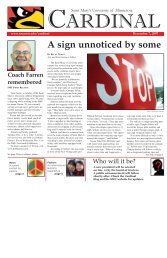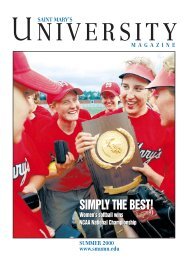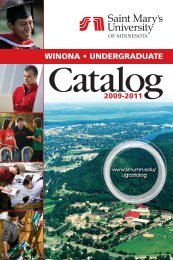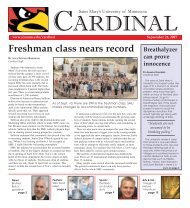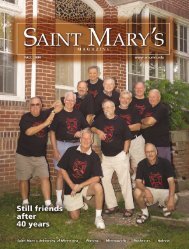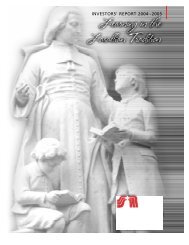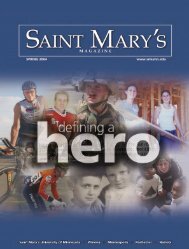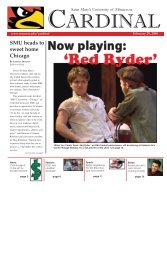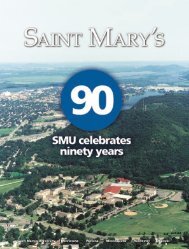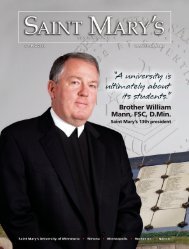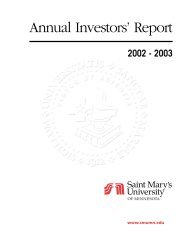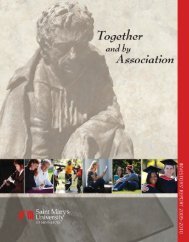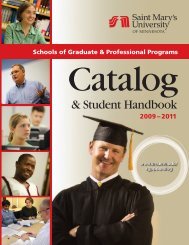PDF version - Saint Mary's University of Minnesota
PDF version - Saint Mary's University of Minnesota
PDF version - Saint Mary's University of Minnesota
Create successful ePaper yourself
Turn your PDF publications into a flip-book with our unique Google optimized e-Paper software.
History<br />
H367 Europe in the Era <strong>of</strong> World War 1914-1945 3 credits<br />
This course is an introduction to Europe’s “thirty year crisis,” from the outbreak <strong>of</strong> World War I in 1914 to<br />
the end <strong>of</strong> World War II in 1945. Europe’s period <strong>of</strong> progress and optimism was shattered by the “Great<br />
War” in 1914. Four years <strong>of</strong> violence created the crucible out <strong>of</strong> which the monster <strong>of</strong> fascism arose. This<br />
led to an even larger war only twenty years later. During WWII, mass slaughter became commonplace,<br />
from the Nazi Holocaust to the Allies’ strategic bombing campaigns, which targeted civilian populations.<br />
Using a variety <strong>of</strong> sources, the course examines the big picture <strong>of</strong> great power confrontations, but also<br />
how the wars were experienced by individuals.<br />
H368 Contemporary Europe 3 credits<br />
This course is an introduction to the history <strong>of</strong> both Western and Eastern Europe since 1945, starting<br />
with the post-war recovery, and ending with the paradox <strong>of</strong> Europe in recent years, during which<br />
Europeans have been moving toward integration (the European Union) while at the same time<br />
experiencing inter-ethnic warfare (the Balkan wars). The course studies such major trends as the Cold<br />
War, decolonization, and the collapse <strong>of</strong> communism. Among a variety <strong>of</strong> primary sources, the course<br />
uses some <strong>of</strong> the popular culture <strong>of</strong> post-war Europe, especially film and rock music.<br />
H370 Research and Writing 3 credits<br />
This is a junior-level course required for those intending to major in history or history/social science. It is<br />
also recommended but not required for those intending to minor in history, and for those who are social<br />
science education majors. It serves as an introduction to the critical thinking skills and dispositions<br />
used by historians as well as some <strong>of</strong> the basic research techniques employed by historians in research<br />
papers. The course requires students engage in their own research and writing, but focus on a broad<br />
topic <strong>of</strong> the instructor’s choosing that will enable the instructor to introduce students to various source<br />
bases, research methods, argument strategies, and theories/epistemologies that may inform their senior<br />
theses. Students are encouraged to start developing their senior thesis projects, especially as a way <strong>of</strong><br />
transferring the knowledge gained from studying the course’s topic to a topic <strong>of</strong> their own choosing so<br />
it can dovetail with the senior thesis course. Prerequisite: H270.<br />
H380 Imperial Russia 3 credits<br />
This course is an introduction to the political, social, economic and cultural history <strong>of</strong> the Russian Empire<br />
from its origins to the fall <strong>of</strong> the Romanovs. The course emphasizes the crisis <strong>of</strong> the old regime between<br />
the period <strong>of</strong> the Great Reforms <strong>of</strong> the 1860s and the revolution <strong>of</strong> 1917. In addition to works by<br />
historians, this course uses a variety <strong>of</strong> primary sources, including memoirs, manifestos, letters, and also<br />
works <strong>of</strong> literature by such authors as Aksakov, Turgenev and Tolstoy. The course seeks to lay a basis for<br />
understanding the Bolshevik experiment <strong>of</strong> the 20th century, as well as Russia’s contemporary struggle<br />
to define its identity after the collapse <strong>of</strong> the Soviet state.<br />
H381 Revolutionary and Post-Revolutionary Russia 3 credits<br />
The Soviet Union disintegrated into 15 new states, the largest <strong>of</strong> which is Russia, in 1991. This event<br />
was widely heralded in the West as a turn to democratic capitalism; a decade later this was no longer<br />
so clear. This course lays the basis for an informed understanding <strong>of</strong> today’s Russia by introducing its<br />
history in this century. The course highlights the revolutionary period including the Bolshevik seizure<br />
<strong>of</strong> power and Stalin’s “second revolution,” and also the recent past, including the periods dominated<br />
by Mikhail Gorbachev and Boris Yeltsin. In addition to works by historians, the course uses a variety <strong>of</strong><br />
primary sources, including speeches, manifestos, eyewitness accounts, novels, and a series <strong>of</strong> influential<br />
Soviet films.<br />
H390 Modern China 3 credits<br />
This is a survey <strong>of</strong> Chinese history from the rise <strong>of</strong> the Qing Dynasty in the mid-17th century to the<br />
protest and repression <strong>of</strong> 1989. It discusses some <strong>of</strong> the main social, economic, cultural, political, and<br />
intellectual features <strong>of</strong> the “traditional” Chinese world the first Qing emperors ruled. It also covers the<br />
way this world changed as China experienced a series <strong>of</strong> convulsive events, including both threats from<br />
116



